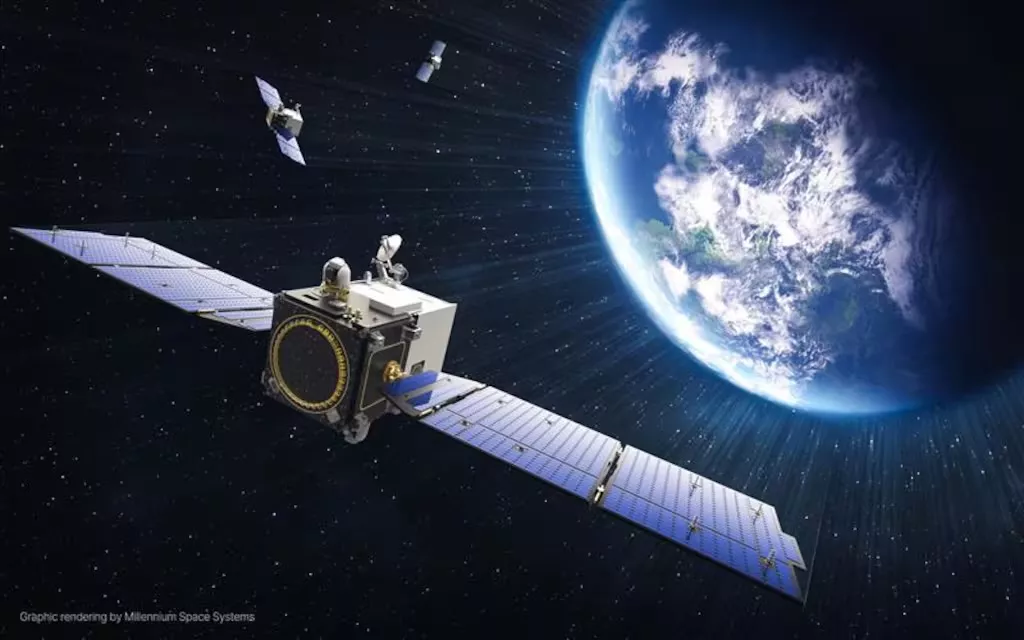美國太空軍斥資12億美元 打造新一代導彈追蹤衛星網絡

(Millennium Space Systems)
美國太空軍(U.S. Space Force)於2025年5月29日宣布,授予BAE Systems Space and Mission Systems(前身為Ball Aerospace)一項價值12億美元的合約,負責建造10顆中地球軌道(MEO)導彈預警與追蹤衛星,作為其「Resilient Missile Warning and Tracking」計劃第二階段(Epoch 2)的一部分。
📌 項目概覽
- 合約金額:12億美元
- 衛星數量:10顆
- 軌道類型:中地球軌道(MEO),距地表約1,200至22,000英里(約1,931至35,405公里)
- 交付時間:預計在2029財年交付
- 主要目標:強化對高超音速與彈道導彈的全球追蹤能力,提升導彈預警系統的彈性與可靠性
🛰️ 技術特點與戰略意義
- 先進紅外線感測器:新一代衛星將配備更成熟的紅外線感測技術,能夠從發射到飛行全程追蹤高超音速與彈道導彈。
- 資料融合與光學互聯:衛星將具備資料融合能力與光學互聯功能,提升即時數據傳輸與任務管理效率。
- 與「黃金圓頂」(Golden Dome)計劃整合:該衛星星座將成為美國總統川普提出的「黃金圓頂」國土導彈防禦計劃的一部分,該計劃預計耗資1,750億美元,旨在建立全面的導彈預警與攔截能力。
🔄 計劃進展與未來展望
- 分階段部署:太空軍計劃每兩至三年推出新一代衛星,逐步擴展與升級導彈預警與追蹤能力。
- 與其他機構合作:該計劃與太空發展局(SDA)和導彈防禦局(MDA)合作,採取「聯合計劃辦公室」模式,加速關鍵能力的交付。
🌐 地理位置資訊
- 中地球軌道(MEO):衛星將部署於中地球軌道,距地表約1,200至22,000英里(約1,931至35,405公里),位於低地球軌道(LEO)與地球同步軌道(GEO)之間。
🕊️ 和平視角補充
儘管這項計劃旨在提升導彈預警與追蹤能力,但其背後也反映出當前國際安全局勢的緊張與不確定性。 在推動技術發展的同時,國際社會更應重視外交對話與和平機制的建立,以避免軍備競賽的升級。 透過透明的資訊公開與民眾參與,才能共同維護全球和平與安全。
U.S. Space Force Awards $1.2 Billion Contract to BAE for Missile Tracking Satellites
On May 29, 2025, the U.S. Space Force announced the award of a $1.2 billion contract to BAE Systems Space and Mission Systems (formerly Ball Aerospace) to build 10 medium Earth orbit (MEO) missile warning and tracking satellites. This initiative is part of the second phase (Epoch 2) of the Resilient Missile Warning and Tracking program.
📌 Project Overview
- Contract Value: $1.2 billion
- Number of Satellites: 10
- Orbital Type: Medium Earth Orbit (MEO), approximately 1,200 to 22,000 miles (1,931 to 35,405 km) above Earth
- Delivery Timeline: Expected in Fiscal Year 2029
- Primary Objective: To enhance global tracking capabilities for hypersonic and ballistic missiles, and improve the resilience and reliability of the missile warning system
🛰️ Technical Features and Strategic Significance
- Advanced Infrared Sensors:
The next-generation satellites will be equipped with advanced infrared sensor technologies capable of tracking hypersonic and ballistic missiles throughout their entire flight path. - Data Fusion and Optical Interconnectivity:
These satellites will incorporate data fusion capabilities and optical links to improve real-time data transmission and mission coordination. - Integration with the “Golden Dome” Initiative:
The satellite constellation will be part of the “Golden Dome” homeland missile defense strategy, a $175 billion initiative proposed by President Trump aimed at building a comprehensive missile warning and interception capability.
🔄 Program Development and Future Outlook
- Phased Deployment:
The Space Force plans to roll out new generations of satellites every 2–3 years to incrementally expand and upgrade missile tracking and warning capabilities. - Interagency Collaboration:
The program is being developed in coordination with the Space Development Agency (SDA) and the Missile Defense Agency (MDA), utilizing a “Joint Program Office” model to accelerate delivery of critical capabilities.
🌐 Geographical Deployment Information
- Medium Earth Orbit (MEO):
The satellites will be deployed in MEO, orbiting between 1,200 and 22,000 miles (1,931 to 35,405 km) above the Earth—between low Earth orbit (LEO) and geosynchronous orbit (GEO).
🕊️ Peace Perspective
While the program is intended to enhance missile warning and tracking capabilities, it also reflects the growing tension and uncertainty in the current international security environment. As technological development progresses, the international community should place greater emphasis on diplomacy and peace-building mechanisms to avoid the escalation of arms races. Transparency and public participation are essential for upholding global peace and stability.




回應文章建議規則: